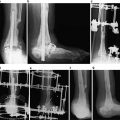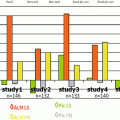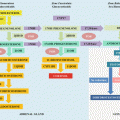Hyperthyroidism associated with elevated or normal thyroid radioactive iodine uptake
Graves’ hyperthyroidisma
Multinodular goiter or toxic adenoma TSH-producing pituitary adenomab
Some cases of thyroid hormone resistance
Hyperthyroidism associated with trophoblastic disease
TSH receptor-activating mutations
Hyperthyroidism in some cases of McCune–Albright syndrome
Hyperthyroidism Associated with Normal RAIU
Thyrotoxicosis Associated with Very Low or Near-Zero (Table 2.2) Neck RAIU [2, 5]
Table 2.2
Causes of thyrotoxicosis
Thyrotoxicosis associated with near-zero thyroid radioactive iodine uptake |
|---|
Silent thyroiditis |
Postpartum thyroiditis |
Granulomatous (subacute thyroiditis or de Quervain’s) |
Acute infectious thyroiditis |
External beam radiation-induced thyroiditis |
Extensive metastatic follicular cancer after thyroidectomy |
Iatrogenic thyroiditis |
Factitious thyroiditis |
Struma ovarii |
Bleeding into functioning thyroid nodule |
Amiodarone-induced thyroiditis |
Drug-induced and biotherapy-induced thyroiditis |
Thyrotoxicosis from meat or sausage with high thyroid tissue contamination |
Iodine-induced hyperthyroidism |
Any hyperthyroid cause associated with exogenous iodine ingestion or iodinated radiologic contrast (depending on the cause uptake may be low but not near zero) |
These include iodine-induced hyperthyroidism, silent thyroiditis [14, 15], postpartum thyroiditis [16], and any form of thyrotoxicosis associated with exogenous iodine. One rare cause is struma ovarii [17] when thyroid RAIU is very low and pelvic ultrasound followed by pelvic radioactive iodine scan will be diagnostic. Silent and postpartum thyroiditis have a similar course as subacute granulomatous thyroiditis but pain is not present and etiologies are either autoimmune [16] or drugs. Sedimentation rate will be normal and antithyroid antibodies will be positive. For diagnosis of silent thyroiditis absence of history of iodine intake and iodinated contrast studies are needed and for confirmation urinary iodine measurement is helpful. Transient thyrotoxicosis states are treated with nonselective beta-blockers such as propranolol (Table 2.3).
Table 2.3
Medications commonly used in management of thyrotoxicosis
Symptomatic therapy | ||
Short-acting propranolola | 10–40 mg | TID–QID |
Slow-release propranolol | 70–240 mg | QD–BID |
Atenololb | 25–100 mg | QD–BID |
Nadololc | 40–160 mg | QD |
Antithyroid medications | ||
Methimazole, starting dosed | 10–40 mg/day | QD–BID |
Methimazole, maintenance dose | 5–20 mg/day | QD |
Propylthiouracil (PTU), starting dosee | 100–400 mg/day | TID |
Propylthiouracil (PTU), maintenance dose | 50–200 mg/day | BID–TID |
Thyrotoxicosis with Low Thyroid RAIU and Low Serum Thyroglobulin
Iatrogenic and factitious thyrotoxicosis is associated with low RAIU [18]. In the presence of small thyroid size and thyrotoxicosis associated with very low thyroid RAI uptake and absence of iodine contamination, if factitious thyrotoxicosis is suspected a very low serum thyroglobulin should suggest exogenous factitious or inadvertent thyroid hormone intake, even if patient does not volunteer the history. If thyroglobulin antibodies are positive it interferes with the assay and low thyroglobulin is not reliable. It should be noted that serum thyroglobulin may be normal if patient has preexisting nodular goiter concurrent with excess thyroid hormone intake. Consumption of hamburger and sausages containing thyroid has also been associated with exogenous thyrotoxicosis in some reported cases [19].
Thyrotoxicosis Presenting with Neck Pain
There are three conditions that present with thyroid pain and thyrotoxicosis. The most common is granulomatous thyroiditis or de Quervain’s thyroiditis [20], most likely a viral condition. It usually follows an upper respiratory infection, is associated with a febrile illness, and presents with exquisite thyroid pain and tenderness radiating to ears and very firm and irregular thyroid. One lobe can be involved first followed by the other. Thyroid hormone levels are elevated, TSH is suppressed, RAIU is close to zero, sedimentation rate is high, blood count is normal, and serum thyroglobulin level is elevated [14]. Condition is followed by a transient hypothyroid phase and less commonly (in 5–15 %) by permanent hypothyroidism. The process lasts few months. Management of thyrotoxicosis is by nonselective beta-blockers (Table 2.3) and nonsteroidal anti-inflammatory agents (NSAIDS) and in severe cases by a short course of corticosteroids. Recurrence may occur in 2–5 % after several years. Suppurative thyroiditis also presents with thyroid pain but has a different presentation and course.
The second cause of painful transient thyrotoxicosis is bleeding into a functioning nodule resulting in release of stored hormones. This will be unilateral with distinct palpable nodule. ESR is normal, radioactive iodine uptake is low, and serum thyroglobulin levels are extremely high. Diagnosis is by thyroid ultrasound. Symptoms are usually mild; pain has a short duration. Duration of hyperthyroidism is also shorter than subacute thyroiditis.
The third cause is rare association of thyrotoxicosis with suppurative thyroiditis. Bacterial infection of thyroid and abscess formation are rare. Infection may occur after procedures or spontaneously and also from infected piriform sinus fistula [21]. It is associated with fever and local inflammatory signs and symptoms and abnormal blood count. Diagnosis is with neck ultrasound showing abscess formation. Fine needle aspiration (FNA) and culture establish the infectious etiology. Thyrotoxicosis is usually short lived and may be masked by inflammatory and systemic symptoms [22]. Management is management of infection and beta-blocker for thyrotoxicosis symptoms.
Drug-Induced Thyrotoxicosis and Hyperthyroidism
Iodine-containing contrast media can cause iodine-induced hyperthyroidism particularly in iodine-deficient areas and in patients with nodular goiter. The duration depends on the half-life of clearance of exogenous iodine. In case of radiologic contrast media usually it will be a few weeks or months; in case of amiodarone it is several months to a year. Lithium [23, 24], interferon gamma, interleukin-2, and anti-cytokine therapies and biotherapies can cause transient painless thyroiditis that lasts weeks to few months and should be managed with beta-blockers and supportive care. Sometimes thyroid autoimmunity such as Graves’ disease is induced by these medications. Tyrosine kinase inhibitors and thalidomide derivatives may cause thyroid dysfunction and sometimes thyroiditis with transient hyperthyroidism [25].
Amiodarone-Induced Thyrotoxicosis
This is one of the most difficult management problems in thyroidology [26]. Patients usually have a critical and sometimes life-threatening cardiac arrhythmia. Amiodarone has high concentration of iodine and after discontinuation of therapy may stay in the body up to 6–12 months. Thyroid RAIU is not helpful for diagnosis because it is low due to a high iodine pool. Two types of thyrotoxicosis are recognized with amiodarone: Type I is iodine induced and more common in iodine-deficient areas. Type II, a toxic destructive thyroiditis, is the more common type. Type I occurs usually in the background of nodular goiter [26]. It is essential to differentiate these two types since therapies are quite different. Therapy of type I includes antithyroid drugs and discontinuation of amiodarone; therapy of type II is corticosteroids. Ultrasound of thyroid is helpful in differentiation of these two: In type II thyroid size is usually normal and thyroid is distinctly hypovascular [27]. The problem is that although 90 % of the cases are type II, many cases are mixed and thyrotoxicosis develops as a result of both release and increased production of hormones. Although pure type II should respond to corticosteroids within 2–5 weeks, sometimes combination empiric therapy with methimazole along with corticosteroids may be needed. Early response to corticosteroids and normalization of thyroid function within 2–5 weeks favor type II diagnosis. Amiodarone therapy should be stopped if possible, since iodine-induced type will continue and type II thyroiditis may recur. Some cases may not respond to medical therapy and in those surgery is a good option for rapid cure [26, 28, 29].
Subclinical Hyperthyroidism
Subclinical hypothyroidism is defined by lower than normal serum TSH, not explained by other causes such as pituitary disease, medications and acute illness, and normal levels of T3 and T4 [3]. This condition is more common than overt symptomatic hyperthyroidism. Etiologies are similar to clinical hyperthyroidism and thyrotoxicosis. It is present in mild Graves’ disease or early-stage autoimmune disease or in toxic nodular goiter. Approximately 50 % of subclinical hyperthyroidism cases have subtle symptoms such as increased pulse rate. Symptoms are usually absent if TSH is >0.1 mIU. Younger individuals may tolerate the condition without adverse effects but in postmenopausal women increased bone loss is the consequence. Individuals older than 60 years have three times higher likelihood of having atrial fibrillation [30]. There is some evidence from epidemiologic studies suggesting increased mortality with serum TSH <0.5. Thus persistent subclinical hyperthyroidism should be treated in this group [31]. Therapy depends on etiology. In cases of toxic adenoma or multinodular goiter resolution of subclinical hyperthyroidism is unlikely and definitive therapy with radioactive iodine or surgery should be recommended. More than one abnormal test over time is needed before intervention.
Transient causes such as silent and subacute thyroiditis can be managed by beta-blockers waiting for resolution. In subclinical Graves’ disease antithyroid and RAI therapy are equally effective. In younger age group beta-blocker therapy alone or observation is acceptable [32].
Hyperthyroidism Associated with Pregnancy
Differentiation of physiologic gestational thyrotoxicosis from hyperthyroidism in the first 3 months of pregnancy is important and often difficult [33]. Thyroid is stimulated by human chorionic gonadotropin (HCG), TSH may be low or even suppressed, and symptoms may also be misleading. Very high levels of free T4, presence of goiter, and positive TRAB are helpful for diagnosis. Preexisting Graves’ disease may improve during pregnancy and may relapse after childbirth. Treatment of hyperthyroidism is PTU in the first 3 months because of teratogenic effect of methimazole [34] but after first trimester PTU can be switched to methimazole because of its lower side effect profile. Total T4 should be kept 1.5 times above the upper limit of normal and free T4 at the upper limit of normal to prevent fetal hypothyroidism. Surgery can be done only in the second trimester if there are adverse reactions to antithyroid therapies or large doses of antithyroids are required for control of hyperthyroidism [35].
Because TRAB cross placenta and can affect fetal thyroid, these antibodies should be checked in patients with current or previous history of Graves’ disease or a history of neonatal Graves’ or previous elevated TRAB. If TRAB is positive at 2–3 times above normal fetal thyroid should be monitored by ultrasound at 18–22 weeks and repeated every 4–6 weeks. Evidence of fetal hyperthyroidism is goiter, hydrops, advanced fetal bone age, increased pulse, and cardiac failure. In this case even if the mother is euthyroid on thyroxine therapy methimazole of PTU should be given with close monitoring. There is no evidence that subclinical hyperthyroidism has adverse effect in pregnancy for the fetus and mother; thus therapy is not recommended [35].
Hyperthyroidism in Trophoblastic Disease
HCG and TSH have similarities in their structure and receptors. Thus in the first trimester of pregnancy TSH levels are low and have inverse relationship with HCG levels. Mild physiologic thyrotoxicosis by HCG stimulation may be present that may be more pronounced in hyperemesis gravidarum [35]. Very high levels of HCG in hydatiform mole and choriocarcinoma [17] can present with significant hyperthyroidism and even thyroid storm [36, 37]. Treatment is management of the trophoblastic condition.
Hyperthyroidism with Inappropriately Normal Serum TSH in TSH-Producing Pituitary Adenoma
In the presence of inappropriately normal serum TSH with elevated thyroid hormone levels and symptoms of hyperthyroidism, laboratory artifacts such as heterophile antibodies and abnormal binding to proteins should be excluded, as should thyroid hormone resistance. An MRI of pituitary should follow. Elevated beta-subunit will be in favor of TSH-secreting pituitary adenoma causing hyperthyroidism. These cases are very rare [2].
Hyperthyroidism in Thyroid Hormone Resistance
Most patients with generalized thyroid hormone resistance have elevated peripheral thyroid hormone levels and inappropriately normal serum TSH and are clinically euthyroid [38]. If there is pituitary thyroid hormone resistance or if the degree of resistance is higher in the pituitary than peripheral tissues hyperthyroidism may occur [39]. Diagnosis of this rare condition is difficult and should be guided by clinical evaluation surrogates of excess thyroxine effects such as sex hormone-binding globulin (SHBG) may be useful.
Thyrotoxicosis Associated with “Café au Lait” Pigmentation and Fibrous Dysplasia (McCune–Albright Syndrome)
In this syndrome associated with polyostotic fibrous dysplasia and “café au lait” pigmentation, because of constitutive activation of G(s) alpha by inhibition of its GTPase, non-autoimmune hyperthyroidism may develop and may be associated with nodular goiter. In this rare syndrome treatment is surgery or RAI ablation. Remission with antithyroid medications does not occur.
Non-autoimmune Hyperthyroidism Caused by Genetic Mutation of TSH Receptor
Germline activating mutation of TSH receptor is a rare cause of hyperthyroidism in infancy and childhood. Best treatment after preparation with antithyroid medications is surgery at appropriate age. In adult patients RAI therapy can also be considered [40]. Activating mutations can also result in toxic adenoma that may present in adulthood.
Metastatic Follicular Cancer and Hyperthyroidism
Thyrotoxicosis is rarely a presenting picture in widespread metastatic follicular cancer. Occasionally it may present after excision of the primary tumor and may resolve with radioactive iodine therapy or excision of bulky tumors. It also can present with T3 toxicosis because of high rate of conversion of exogenous T4 to T3 of the therapeutic administered T4 by tumor that expresses high di-iodinase.
Hyperthyroidism Associated with Normal T4 and Elevated T3 (T3 Toxicosis)
It is doubtful that T3 toxicosis is a distinct entity [2]. In the early phase of hyperthyroidism only T3 elevation may be present and T4 elevation occurs later. It is conceivable that in iodine-deficient areas and in certain conditions more T3 than T4 may be produced. Patients with hyperthyroidism on antithyroid therapy and after RAI therapy may have normal free T4 and elevated free T3.
Patients on excess thyroid extract therapy also have T3 toxicosis which can be associated with normal or low free T4, suppressed TSH, and elevated free T3 levels. This is due to excess T3-to-T4 ratio in the commercial product. In patients with thyroid extract therapy measurement of peripheral hormones does not correlate with thyroid function status and TSH measurement is the definitive test for assessment of therapy.
Laboratory Investigation of Thyrotoxicosis and Hyperthyroidism
Although the first and most sensitive test in the presence of normal pituitary function is serum TSH, yet it is only an indirect measure of thyroid function and when thyrotoxicosis is suspected circulating hormone levels such as free T4 and free T3 should be measured [2]. First, free T4 should be measured and, if normal, measurement of free T3 should follow. To differentiate between the two main categories, high and low RAIU thyrotoxicosis, thyroid RAIU should be measured next [2]. Thyroid scan usually is not needed except for cases of nodular disease with hyperthyroidism [2]. Ultrasound is sometimes helpful in the differential diagnosis. Ultrasound identifies nodule size, number, and vascularity. Increased vascularity in a diffuse goiter suggests Graves’ disease, whereas low vascularity is seen in cases of destructive thyroiditis such as amiodarone-induced hyperthyroidism [27]. Also in cases of Graves’ disease associated significant conditions such as occult malignancy change the management. When there is doubt about the etiology and also for prognostic assessment, measurement of TRAB is helpful [8]. Thyroid-stimulating immunoglobulin assay, a bioassay, is more expensive and is being replaced by immunoassay of TRAB.
Management of Thyrotoxicosis and Hyperthyroidism
For transient conditions such as silent, subacute, and postpartum thyroiditis and all conditions associated with the release of stored thyroid hormones, symptomatic therapy with nonselective beta-blocker medications (Table 2.3) are adequate as noted previously [2]. Two major and common causes of hyperthyroidism, Graves’ disease and multinodular toxic goiter, require more detailed discussion.
Stay updated, free articles. Join our Telegram channel

Full access? Get Clinical Tree






